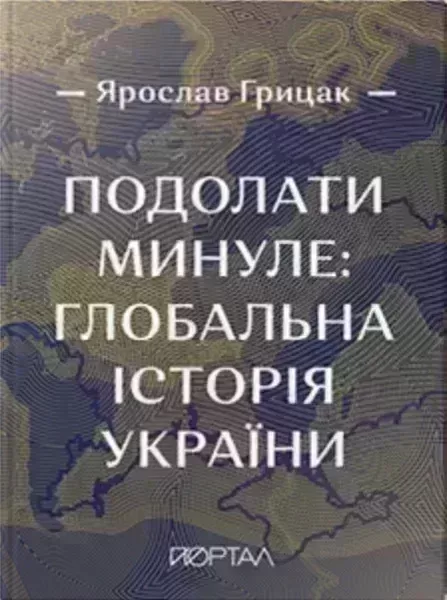Read in: Українська (Ukrainian)

Подолати минуле: глобальна історія України (Overcoming the Past: The Global History of Ukraine)
Ярослав Грицак (Yaroslav Hrytsak)
Київ: Портал, 2021
Hrytsak’s newest book, Подолання минулого: глобальна історія України (Overcoming the Past: The Global History of Ukraine), appeared last November and quotes The Beatles in the introduction, as well as Sting (« As Hegel wrote, and Sting sang, history will teach us nothing »). It explains the difference between 17th-century Ukrainian and Russian orthodoxy with carols (the Catholic origins of caroling meant no carols in Russia). It explains the difference between the Soviet Union and Eastern Europe with rock music (underground in the former, openly available in the latter), and between communist Poland and the other communist countries with The Rolling Stones (they performed in Warsaw and nowhere else).
I might as well note here that I began this essay before the Russian invasion of Ukraine; I am finishing it during that invasion. Hrytsak, meanwhile, has stated that February 24 marked the beginning of a « new era in Ukrainian history »: « We are not ‘Ukrainian people’ anymore » he wrote in a column for Ukrayinska Pravda, « We are the Ukrainian nation now. » The war, he says, calling a spade a spade, is « not Russia’s aggression against Ukraine, but the patriotic war of the Ukrainian nation with Russia. » The book aimed to overcome the past; perhaps the present has in turn overcome the book.
Or, after February 24, maybe the book takes on new poignancy. Hrytsak demonstrated that Ukraine was never an island; its history was always intertwined with the global, even in its deepest Soviet isolation. In 2022, likewise, Ukraine didn’t become an epicenter of world history all of a sudden. It’s truer to say that Ukraine became an epicenter again, only this time the world is watching.
This article is behind the paywall. Want to keep reading this article?
Subscribe to the European Review of Books, from as low as €4,16 per month.
Already a subscriber? Sign in
- A Tatar ship was raided on the Dnieper river; the Crimean khan complained to the grand duke of Lithuania that the perpetrators were Cossacks, then the grand duke’s subjects. Cossacks were martial people of different origins who had settled the lands south of Kyiv. Hrytsak describes them as « pirates of the steppe », « social bandits » in Eric Hobsbawm’s terms—not a pejorative, more like Robin Hood. ↩︎
- Another bombshell history published in 2021 focused precisely on the Commonwealth: in The Ukrainian Universes of the Commonwealth (Українські світи Речі Посполитої. Київ: Laurus, 2021) by Natalya Starchenko. Starchenko challenges the usual notion (Hrytsak’s too) that one of the main causes of the 1648 revolt was the exploitation of peasants; she also cautions against projecting the later histories of serfdom and chattel slavery onto earlier eras. ↩︎
- Shevchenko pops up at every Ukrainian existential moment. During Euromaidan, Shevchenko’s stern visage found its way into street art: walrus mustache, bald head in the open air or under the giant fur cylinder of a hat. The iconic photo with the hat was taken after his comeback from exile in Kazakhstan: under his traditional Ukrainian clothes, a dress coat may be noticed. His birthday, March 9, is the occasion of « Shevchenko days », which this year fell during the invasion. His writings on the Cossack wars can resonate in the current war. The Ukrainian Defense Minister, Oleksii Reznikov, posted a flack-jacketed selfie in front of Shevchenko’s statue in Kyiv; Shevchenko memes abound. ↩︎
- Russian emperor Alexander II issued the decree while vacationing at the German resort Bad Ems. In its 11 points, it banned both the publication and importation of books in the Ukrainian language—original texts and translations. It also banned the Ukrainian language from the theater, from concerts, public readings, and elementary education. Ukrainian books had to be confiscated from the school libraries. Authorities were urged to check the loyalty of schoolteachers: suspicious ones were to be transferred to ethnic Russian regions and replaced by the teachers from there. (The decree recommended such transfers in general.) The Kyiv branch of the Geographical Society was shut down, as was one of the newspapers. The Ems decree remained in effect until the Russian revolution of 1905. ↩︎
- Julian Bachynsky, a young Marxist intellectual in Lviv, part of the student circle that surrounded Franko, articulated the appeal for Ukrainian independence in Україна Irredenta (1895). Hrytsak’s intellectual biography of Ivan Franko has been translated into English by Marta Daria Olynyk: Ivan Franko and His Community (2019). While we’re at it, Hrytsak’s own intellectual hero is not Ivan Franko but Ivan Lysyak-Rudnytsky, a great historical essayist. Lysyak-Rudnytsky was from an influential Galician family of liberal politicians, journalists and intellectuals (his mother was the most prominent figure in the women movement, a vocal feminist); a student at Lviv University until 1939, he would spend the rest of his life in Europe, the USA and Canada. ↩︎
- The 2004 Maidan, also known as Orange revolution, was like the 1989 carnival of Central European non-violent revolutions, transplanted 1000 km to the east and delayed 15 years. The 2013 protest began as non-violent too. The beatings, killings and kidnappings in Kyiv in January and February 2014, by special forces, pro-Russian paramilitary groups and paid thugs, were approved, provoked, and assisted either by the Yanukovych ruling clan, or by Russian agents provocateurs, at least to some extent, and it’s also clear that the separatist coups and war in the Donetsk and Luhansk regions would not have happened if not for Russian infiltration. ↩︎